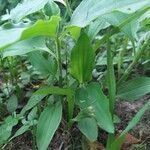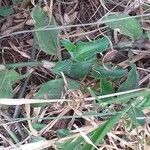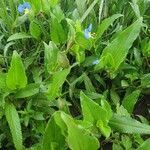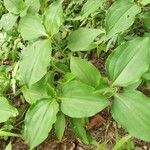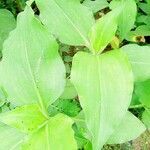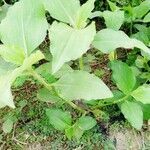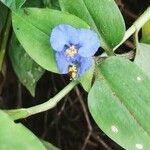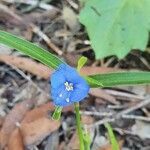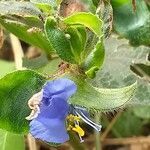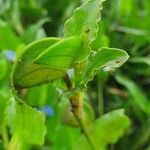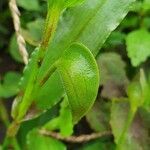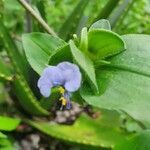A slender, juicy, creeping herb, often with hairs. It has underground branches, as well as branches on the ground surface. Plants continue to grow from year to year. Plants are only about 25 cm high but can spread quite widely. It has roots at the nodes. The leaves are oval, and pointed at both ends. They are wavy along the edge, and 4 to 7 cm long. The leaf clasps the stem. The flowers are blue, with three petals 3 to 4 mm long. The flowers are produced in the axils of the upper leaves during summer. The fruit have 3 cavities, with 2 seeds in 2 of them and one seed in the other. The seeds are about 2 mm long.
Annual spreading herb, 0.2-1.0 m high, pubescent. Leaves pale green, ovate, up to 80 x 30 mm, base narrowed into a sheath, ciliated with reddish or rarely colourless setae at mouth, margins ± crenulate. Spathe subsessile, clustered at apices of branches. Inflorescence of 2 cymes. Flowers enclosed in spathe, top most flower exserted; petals 3, 2 side petals deep ink-blue. Stamens 6, 3 barren. Ovary subglobose, 3-celled; style cylindric; stigma simple. Flowering time Aug.-May. Fruit a 5-seeded capsule, indehiscent.
Annual herb, up to 0.9 m high; spreading. Leaves with blade ovate, green, margins smooth, leaf sheaths often with long red setae at mouth. Flowers: spathes obliquely fused, mucilaginous inside when flowering; petals ink blue; Nov.-May. Fruit quadrate with ventral locules 2-seeded, constricted between seeds, dorsal locule 1-seeded or often aborted.
Spreading, annual herb, often with reduced underground flowers. Roots thin. Leaves ovate, green, margin smooth, leaf sheaths often with long red setae at mouth. Spathes obliquely fused, mucilaginous inside when flowering. Capsule quadrate. Widespread weed. Flowers ink-blue.
Spreading, hairy annual to 30 cm. Leaves ovate. Flowers blue, spathes obliquely fused, mucilaginous inside.
